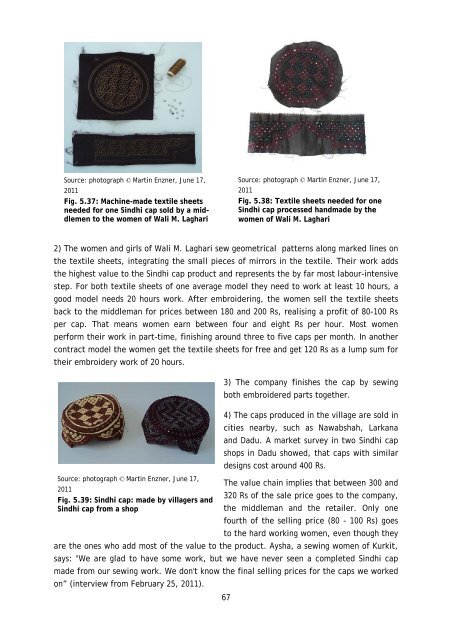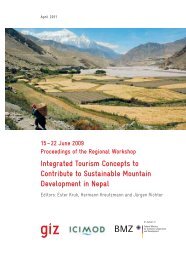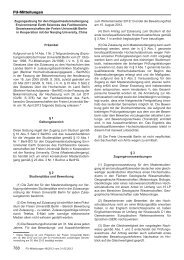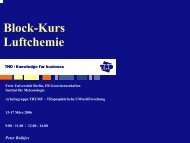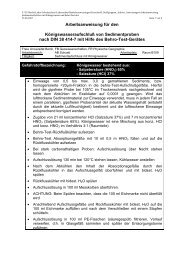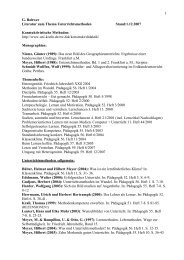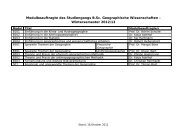After the Flood in Pakistan 38 Berlin Geographical Papers - Freie ...
After the Flood in Pakistan 38 Berlin Geographical Papers - Freie ...
After the Flood in Pakistan 38 Berlin Geographical Papers - Freie ...
You also want an ePaper? Increase the reach of your titles
YUMPU automatically turns print PDFs into web optimized ePapers that Google loves.
Source: photograph ©�Mart<strong>in</strong> Enzner, June 17,<br />
2011<br />
Fig. 5.37: Mach<strong>in</strong>e-made textile sheets<br />
needed for one S<strong>in</strong>dhi cap sold by a middlemen<br />
to <strong>the</strong> women of Wali M. Laghari<br />
2) The women and girls of Wali M. Laghari sew geometrical patterns along marked l<strong>in</strong>es on<br />
<strong>the</strong> textile sheets, <strong>in</strong>tegrat<strong>in</strong>g <strong>the</strong> small pieces of mirrors <strong>in</strong> <strong>the</strong> textile. Their work adds<br />
<strong>the</strong> highest value to <strong>the</strong> S<strong>in</strong>dhi cap product and represents <strong>the</strong> by far most labour-<strong>in</strong>tensive<br />
step. For both textile sheets of one average model <strong>the</strong>y need to work at least 10 hours, a<br />
good model needs 20 hours work. <strong>After</strong> embroider<strong>in</strong>g, <strong>the</strong> women sell <strong>the</strong> textile sheets<br />
back to <strong>the</strong> middleman for prices between 180 and 200 Rs, realis<strong>in</strong>g a profit of 80-100 Rs<br />
per cap. That means women earn between four and eight Rs per hour. Most women<br />
perform <strong>the</strong>ir work <strong>in</strong> part-time, f<strong>in</strong>ish<strong>in</strong>g around three to five caps per month. In ano<strong>the</strong>r<br />
contract model <strong>the</strong> women get <strong>the</strong> textile sheets for free and get 120 Rs as a lump sum for<br />
<strong>the</strong>ir embroidery work of 20 hours.<br />
3) The company f<strong>in</strong>ishes <strong>the</strong> cap by sew<strong>in</strong>g<br />
both embroidered parts toge<strong>the</strong>r.<br />
4) The caps produced <strong>in</strong> <strong>the</strong> village are sold <strong>in</strong><br />
cities nearby, such as Nawabshah, Larkana<br />
and Dadu. A market survey <strong>in</strong> two S<strong>in</strong>dhi cap<br />
shops <strong>in</strong> Dadu showed, that caps with similar<br />
designs cost around 400 Rs.<br />
Source: photograph ©�Mart<strong>in</strong> Enzner, June 17,<br />
The value cha<strong>in</strong> implies that between 300 and<br />
2011<br />
320 Rs of <strong>the</strong> sale price goes to <strong>the</strong> company,<br />
Fig. 5.39: S<strong>in</strong>dhi cap: made by villagers and<br />
S<strong>in</strong>dhi cap from a shop<br />
<strong>the</strong> middleman and <strong>the</strong> retailer. Only one<br />
fourth of <strong>the</strong> sell<strong>in</strong>g price (80 - 100 Rs) goes<br />
to <strong>the</strong> hard work<strong>in</strong>g women, even though <strong>the</strong>y<br />
are <strong>the</strong> ones who add most of <strong>the</strong> value to <strong>the</strong> product. Aysha, a sew<strong>in</strong>g women of Kurkit,<br />
says: "We are glad to have some work, but we have never seen a completed S<strong>in</strong>dhi cap<br />
made from our sew<strong>in</strong>g work. We don't know <strong>the</strong> f<strong>in</strong>al sell<strong>in</strong>g prices for <strong>the</strong> caps we worked<br />
on” (<strong>in</strong>terview from February 25, 2011).<br />
67<br />
Source: photograph © Mart<strong>in</strong> Enzner, June 17,<br />
2011<br />
Fig. 5.<strong>38</strong>: Textile sheets needed for one<br />
S<strong>in</strong>dhi cap processed handmade by <strong>the</strong><br />
women of Wali M. Laghari


